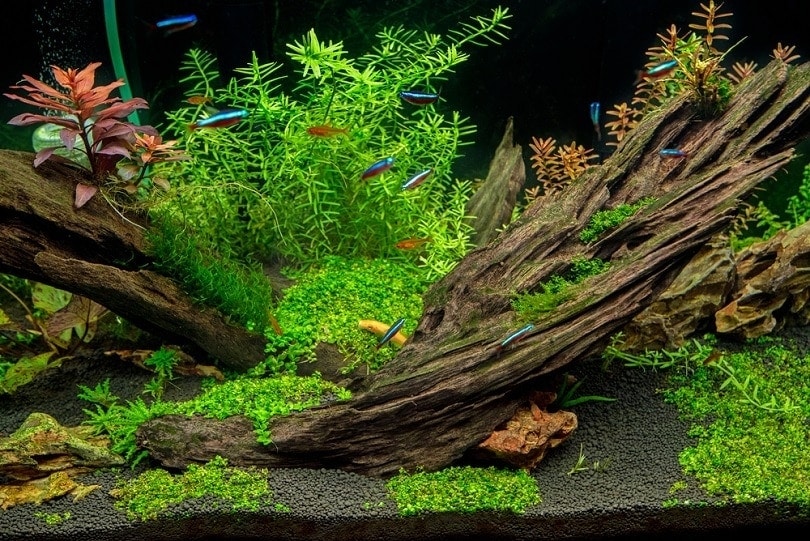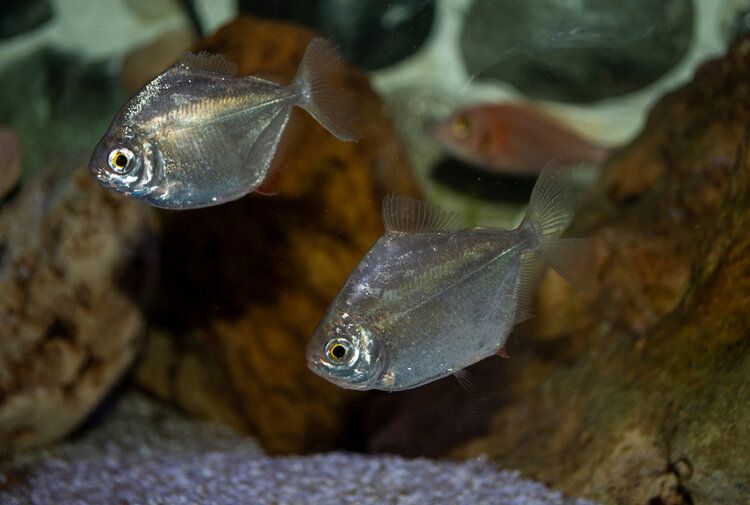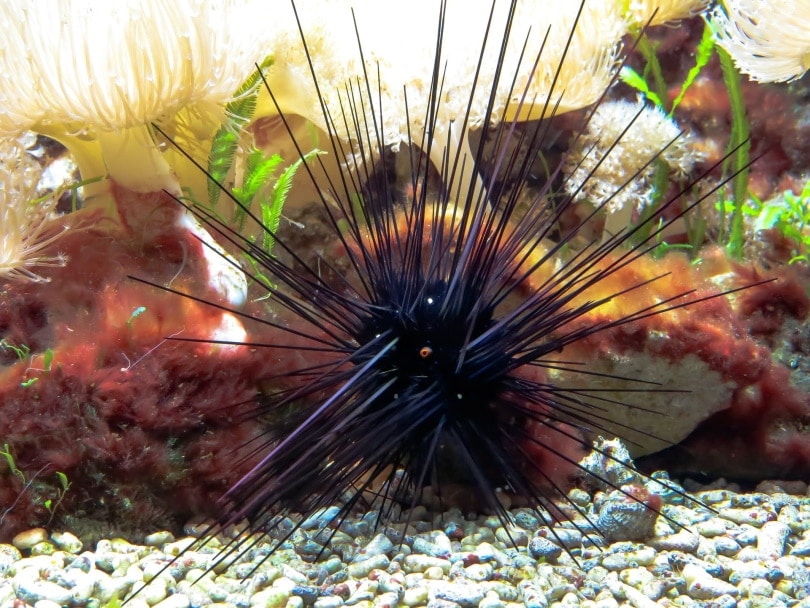Amano Shrimp: Vet-Approved Care Guide, Breeding, Lifespan, Pictures & More

Updated on
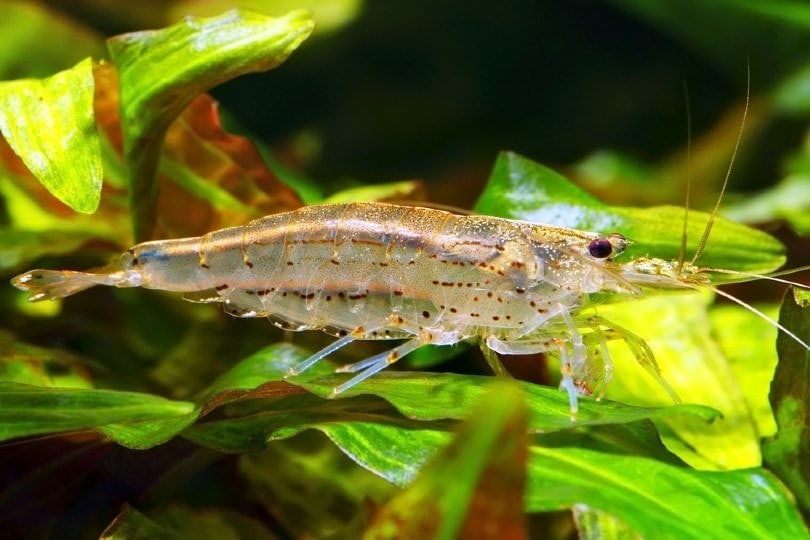
Amano shrimp (Caridina multidentata) are a popular species of shrimp. They do well in community tanks with small fish and thrive in heavily planted set-ups. They are popular freshwater aquarium shrimp that are large enough to survive with more types of fish than other species. Amano shrimp are great swimmers and add life to the bottom of an aquarium. They have a hearty appetite and peaceful nature that makes them a favorite choice of shrimp for many aquarium owners.
- Japanese shrimp
- Yamato shrimp
- Algae eating shrimp
This article will cover everything you need to know about Amano shrimp and inform you on how to keep them healthy!
Quick Facts About Amano Shrimp
| Species Name: | Caridina multidentata |
| Family: | Atyidae |
| Care Level: | Easy |
| Temperature: | 15 – 27°C (59 – 80.6 °F) |
| Temperament: | Peaceful |
| Color Form: | Gray transparent body with reddish brown dots on the side, one white stripe running from head to tail, black eyes. |
| Lifespan: | 2 – 3 years (estimated) |
| Size: | Around 2 inches (5 centimeters) |
| Diet: | Omnivore |
| Minimum Tank Size: | 10 gallons |
| Tank Set-Up: | Freshwater: heavily planted, filtered |
| Compatibility: | Species-only or peaceful community tank |
Amano Shrimp Overview
Amano shrimp quickly became popular when they were brought into the hobby by Takashi Amano. They are well-known for being excellent algae eaters and are good at keeping tanks debris-free. Amano shrimp are typically wild-caught because they are incredibly hard to breed as pets. The broad range of adaptability to different water temperatures of these shrimp makes them excellent for people who are starting in the shrimp hobby. They can handle minor beginner mistakes that would kill the more delicate species of shrimp.
Amano shrimps are native to Japan and Asia, including areas in China and Taiwan. In the wild, they inhabit freshwater streams or rivers. For over a decade, Amano shrimp have captivated the hearts of many hobbyists due to their excellent cleaning ability and active nature.
They will rid your tank of unwanted algae, consume leftover fish food, and generally be enjoyable to watch. Their active nature allows them to be constantly swimming around the bottom part of the tank. Amano shrimp enjoy a heavily planted tank so that they have plenty of hiding spaces and natural foods to eat.
It is easy to keep Amano shrimp healthy if you can meet their undemanding needs. Amano shrimp should be kept in groups of two or more to thrive and portray their wild instincts about breeding, foraging, and grouping.
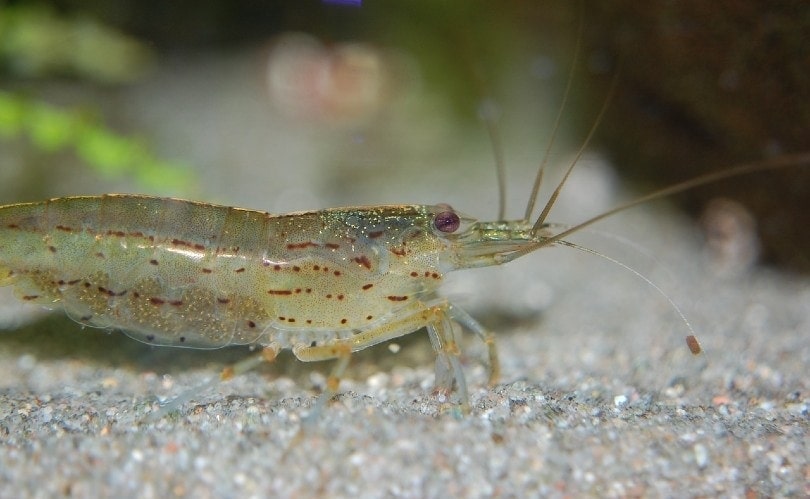
How Much Do Amano Shrimp Cost?
Amano shrimp are an expensive species of shrimp and may be hard to find. Since most Amano shrimp is wild-caught, they are typically found in large-chain pet stores or from shrimp breeders. They are primarily $3 to $10 per shrimp. Online fish stores are guaranteed to sell Amano shrimp, and a group can be bought for as little as $30 depending on how much shipping costs and the number of Amano shrimp you purchase.
Typical Behavior & Temperament
Amano shrimp are generally peaceful and go about their own business in the tank. They can become more boisterous during feeding time, and you may notice them swarming around food or algae. They will sometimes steal sinking foods meant for bottom-dwellers. When it is feeding time, the largest shrimp may try to place a leadership style over the smaller shrimp. Aside from this, they are not aggressive to other fish or themselves.
You will mostly see your shrimp foraging on the substrate and within live plants. They will dig in the substrate to find any morsels of food leftover from fish and even consume the debris and waste that accumulates within the substrate.
Another remarkably interesting behavior Amano shrimp will display is molting, which occurs once a month on average. They shed their exoskeleton shell to grow. They will feel unsafe and go into hiding while they have no shell coverage. This mandates offering them a heavy planted tank with many hiding spots, as a freshly molted shrimp is particularly vulnerable.
- Fun fact: A group of Amano shrimp is called a troupe!
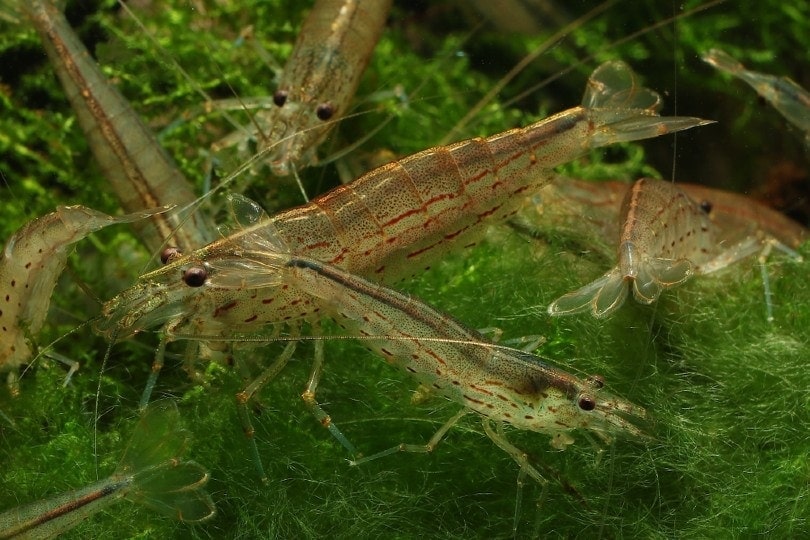
Appearance & Varieties
They are a larger form of dwarf shrimp and are usually around 1 inch when first purchased. They will grow to a maximum size of 2 inches and grow rapidly in warmer water. Amano shrimp have an almost translucent body that is tinted with gray.
They have brown or red lines running along their body, and some may have gray or light blue dots. Their color is enhanced when they are fed a high-quality diet and kept in tropical temperatures. Amano shrimp that consume a lot of algae-based food will usually have a green tint to their bodies. The uropod (shrimp tail) is completely translucent but may take on a brown tint in warm water. Amano shrimp are hard to spot when they are hiding, and their translucent bodies make them able to blend into their environment to avoid predators.
- Male Amano shrimp: The males are smaller than females, and males will have even space between dots. The males lack a saddle underneath their body which is where the female will store eggs.
- Female Amano shrimp: Females are noticeably larger than males, and the dots on their bodies are uneven and may even appear as dashes. The egg nest (saddle) under their body will take on a rounded appearance when they have eggs stored inside.
How to Take Care of Amano Shrimp
Habitat, Tank Conditions & Setup
Tank/Aquarium Size
Amano shrimp should not be kept in small bowls, bio orbs, or vases. These shrimps should be in a tank of at least 10 gallons for a troupe of around eight to 10 shrimp. Anything smaller will not be able to support their breeding and adult size. If you plan to keep your Amano shrimp with other fish or invertebrates, the tank should be 20 gallons or more.
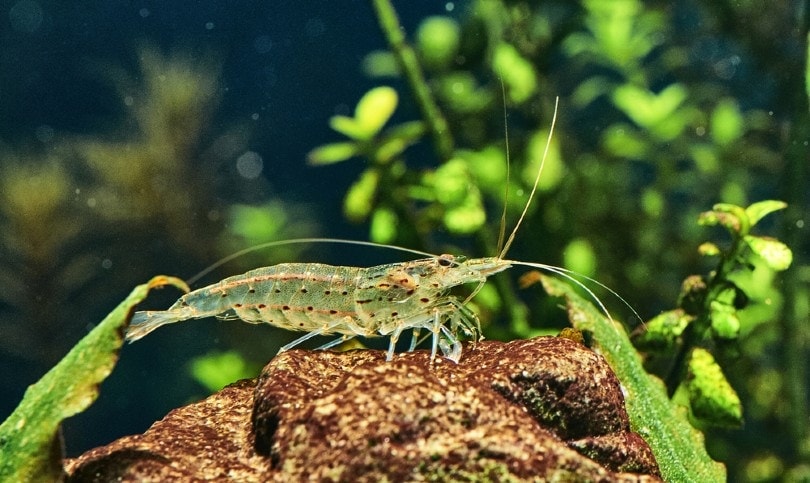
Water Temperature & pH
They can survive in a variety of different water temperatures ranging from 15 – 27°C (59 – 80.6 °F). It is recommended to keep them with a heater with a stable temperature of 25°C (77 °F) or so. The pH should be 6.0 to 8.0, with 7.0 being ideal.
Substrate
Amano shrimp prefer a soil substrate or fine gravel. Darker gravel allows you to see them more easily and will make their colors identifiable amongst the plants and other decorations in the tank.
Plants
Live plants are essential for Amano shrimp. They prefer plants such as java moss, Ludwigia, Elodea, or hornwort. Their tank should be heavily planted to provide hiding spaces for the shrimp.
Lighting
Quality lights will allow you to see your Amano shrimp easier. Lighting will also help the live plants to grow and may also promote algae growth which is an appreciated snack for these shrimps. A white LED light will give you an optimal view of the tank.
Filtration
Filters are an essential part of an Amano shrimp setup. This will help to keep their environment clean and encourage a good establishment of beneficial bacteria. The tank should also have a gentle aeration system to oxygenate the water. Small cartridge or sponge filters are ideal for shrimps. Large filters with a strong intake pose the risk of sucking up the shrimp. The current should be gentle so that they can swim through the tank with ease.
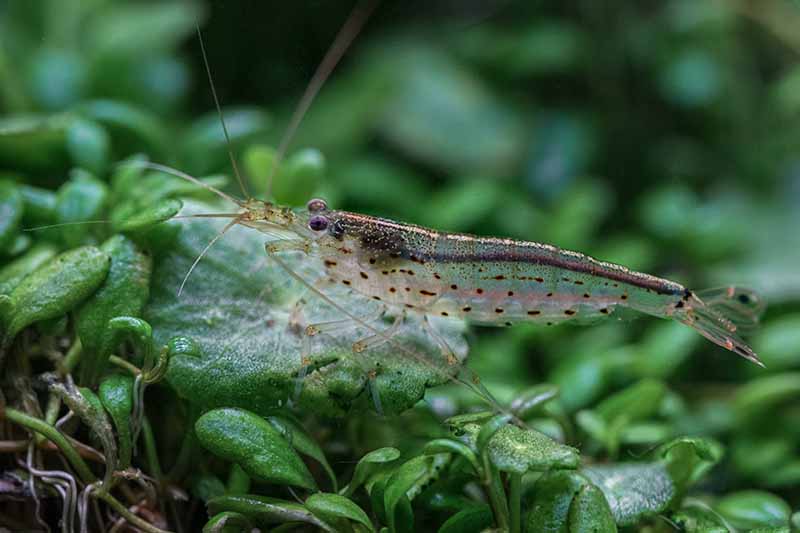
 Are Amano Shrimp Good Tank Mates?
Are Amano Shrimp Good Tank Mates?
Choosing a tank mate(s) for your Amano shrimp should be done carefully. Shrimp are viewed as an easy food source for other fish in the tank. Even the smallest fish will take a nibble on your shrimp which will kill or seriously injure them. This is another reason they need a tank set up with plenty of live plants, they need them to hide.
Most of the time, hiding will not stop a fish from seeking them out. You want to make sure that the tank is large enough to house both the shrimp and fish. If you plan to keep your shrimp in a community tank, it is important to choose suitable tank mates.
Although there are some safe tank mates for Amano shrimp, there is no guarantee that the fish will not eat the shrimp. Losing shrimp to fish can be an expensive and disheartening mistake. If you find that your fish are attempting to harass or eat the shrimp, you should immediately move the shrimp to a species-only tank.
- Mystery snails
- Nerite snails
- Apple snails
- Neon tetras
- Danios
- Harlequin rasbora
- Otocinclus
- Cichlids
- Goldfish
- Oscars
- Arowana
- Jack Dempsey
- Livebearers (mollies, platys, swordtails)
- Red-tailed or rainbow sharks
- Plecos
- Corydoras
- Loaches
- Crayfish
- Gourami
- Angels
Please note that fish that are considered compatible with Amano shrimp may still attempt to make a meal out of younger shrimp. The compatibility of fish listed above assumes that your shrimp are healthy, full-grown adults.
What to Feed Your Amano Shrimp
Contrary to popular belief, the Amano shrimp cannot sustain themselves on algae alone; their diet must be supplemented by different species-appropriate food items.
Algae is their primary dietary requirement and should be available in the tank daily. Amano shrimp are an excellent clean-up crew and will consume whatever foods are left within the tank, but this does not mean that they do not need to be fed their high-quality shrimp food.
They cannot survive on algae and debris in the tank alone. Amano shrimp are omnivores and should be fed an algae-based sinking pellet or wafer. Their diet should be supplemented with blanched vegetables, frozen foods, or pellets formulated for shrimp. Amano shrimp enjoy eating spinach, cucumber, and zucchini.
Frozen foods like bloodworms, brine shrimp, or gel foods can also be fed. Copper is poisonous to shrimp in large quantities and should be avoided as a primary ingredient in the foods they are being fed.

Keeping Your Amano Shrimp Healthy
- Step 1: Keep them in a large tank with a variety of live plants. Amano shrimp enjoy space and will gladly use the permittable space to do their “shrimp” behaviors. The tank should be well maintained and kept free of toxins like certain medications or plant fertilizers that contain copper.
- Step 2: Amano shrimp should be fed a nutritious diet that fulfills all their dietary requirements. Feeding them a good diet will promote growth, resistance to certain diseases, and longevity.
- Step 3: Keep the temperature stable inside the tank by using a preset heater. Though they can adapt to a wide range of temperatures, constantly fluctuating temperatures can induce stress in shrimp and can be potentially fatal if the fluctuations happen too often and too rapidly. Shrimp are more active in tropical conditions and will reach their full-color potential.
- Step 4: Avoid keeping shrimp with aggressive or predatory fish. They will usually hunt and consume a large troupe of shrimp in a matter of minutes. This will stress your shrimp out or cause physical damage that will make them unable to defend themselves or swim away while being attacked.
- Step 5: Keep them in a fully cycled aquarium with a filter. Regular water changes should be done to remove accumulating toxins like ammonia, nitrite, and nitrate. Amano shrimp are sensitive to nitrates, and a spike will cause multiple deaths within the shrimp troupe.
Breeding
Breeding Amano shrimp is a difficult task, and it is even more difficult to successfully raise them from larvae to adulthood. They require brackish water conditions to lay their eggs. The male fertilizes the eggs that the female shrimp will then carry for 6 weeks in her saddle. You may notice the female moving her tail to push oxygen over the eggs.
After 6 weeks of carrying the eggs, the female will release the eggs into brackish water with a high salinity content, and the adult should NOT be placed in the saltwater solution since it will kill them. Once the female has laid the eggs, you should move the female out of the breeder box and then gradually add aquarium salt to incubate the larvae.
Breeding Amano shrimp is mainly done by expert shrimp breeders and is difficult to do as a novice hobbyist. Most success stories of breeding Amano shrimp in captivity are when the shrimp are bred with a salinity content of 1.024. However, this is carefully done through generations of shrimp before any larvae survive.
Conclusion
Now that you know why these shrimps are so popular and respected in the shrimp community, you can start planning a tank for them. It is better to start a tank from scratch and get the conditions right before you place the shrimp in the tank. Designing an Amano shrimp tank setup can be quite fun and allows you to ensure that everything is perfect before you place them inside their new home.
We hope this article has helped inform you on how to correctly own and care for Amano shrimp!
Featured Image Credit: Grigorev Mikhail, Shutterstock



 Are Amano Shrimp Good Tank Mates?
Are Amano Shrimp Good Tank Mates?
